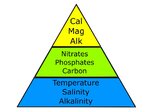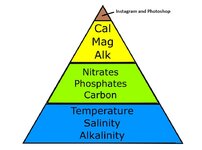Cody
Vice President
Staff member
Administrator
Moderator
Content Moderator
Board Member
Supporting Member

I had, what I believe was, an interesting perspective on our water parameters and corals and wanted to share.
These amazing creatures can provide you with joy, pride, and frustration. When they’re doing well, you’re blown away and excited to look at your tank everyday! When they’re in poor health, you’re downright angry and frustrated. Why won’t these suckers be happy and grow?! I wanted to take a little time to explain the main components of your water parameters and why they matter in a simple to understand way.
When you first get into the hobby, the big three that you hear about are alkalinity, calcium, and magnesium. Keep them in range. Keep them stable. Are they important? Absolutely. Why? I will explain my perspective on that by using your own physical body as an example.
A Hospitable environment: Temperature, salinity, and alkalinity
Just like yourself, these corals are living and breathing organisms that can thrive under certain circumstances and can die in others. You can’t live in 30 degree weather (without clothes and housing, which these corals obviously don’t have), a lack of oxygen, etc. You have basic biological demands that must be met before you can even consider something like diet, growth, reproduction, etc. For corals, temperature, salinity, and alkalinity are the basic demands that must be met. Temperature, well, Is temperature. It needs to be close to their natural environment. Salinity is the concentration of salt dissolved in the water. These corals evolve in an environment that had a certain acceptable amount of salt in the water. Alkalinity is the measurement of how alkaline (opposite of acidic) the water is. All three must be met before coral life can be considered.
Food: Nitrates, phosphates, and carbon
Now that we have a person in livable conditions, what else do they need? They need food and water. Well, corals have the water situation covered pretty well considering that we all put watering bottles for them to drink from in our tanks, duh! What about food, though? I saw a National Geographic documentary about reefs that claimed that 95%+ of the proteins, carbohydrates, amino acids, etc. (aka food) that corals use to grow is produced via photosynthesis. I’m not sure how truthful this is because I could never locate the source of the study. However, I know that if I turn my lights off for a week, black out the tank, and heavily feed coral food, once the lights come on, the corals will probably be dead, or at least looking dire. If I don’t feed coral food for a week and keep the lights on, they’ll be just as healthy as the day I stopped feeding coral food. This leads me to believe there is truth in the numbers National Geographic referenced, or at least in the fact that most of their food is produced via photosynthesis (which requires nitrogen, phosphorous, and carbon), and that coral food is akin to you taking a daily vitamin. They can potentially help, but they can’t live exclusively off of them.
Housing (Softies): Carbonate (alkalinity), Calcium, and Magnesium
Now that we have a livable environment and plenty of food to eat, what next? Well, not a lot. Calcium, magnesium, strontium, etc. have no major role in the growth of softies, other than just being part of the environment in which they evolved. I’m sure that their tissue has traces of these type of elements in them, but because softies don’t grow skeletons, these elements don’t play a major role the way they do with calcifying corals, so they won’t be depleted or need to be dosed the same way they would in an LPS or SPS tank. Water changes should be enough in nearly all applications.
Housing (LPS and SPS) Carbonate (alkalinity), Calcium, and Magnesium
A livable environment has been established, nutrients are readily available (aka food that can be produced via photosynthesis), and the coral is thriving. What next? Well, they start growing skeletons to expand their colony, or rather, make larger homes now that they have everything else that they need. To do so, calcium, carbonate, magnesium, etc. are needed. These will be reduced in the water column as the skeleton grows and will need to be replenished.
Summary
I said all that to illustrate how and why those elements and compounds are used by the coral. You need a hospitable environment, ability to produce food, then the materials to expand your colony/home. The point is to illustrate the importance of these elements/compounds. If you’re only going to chase three elements/compounds then I wouldn’t put calcium and magnesium on that list. I would focus on alkalinity, nitrates, and phosphates (assuming temperature and salinity are in range and stable). Until those first three parameters are suitable, your corals won’t consume calcium or magnesium at a notable rate, and shouldn’t be focused on until the previous parameters have been figured out.













